Environmental Research Complex [ERC] Facilities
Facilities
- Future Students
- JCU Global Experience
- International Students
- Open Day
- How to apply
- Pathways to university
- Virtual Open Day
- Living on Campus
- Courses
- Publications
- Scholarships
- Parents and Partners
- JCU Heroes Programs
- Aboriginal and Torres Strait Islander in Marine Science
- Elite Athletes
- Defence
- Current Students
- New students
- JCU Orientation
- LearnJCU
- Placements
- CEE
- Unicare Centre and Unicampus Kids
- Graduation
- Off-Campus Students
- JCU Job Ready
- Safety and Wellbeing
- JCU Prizes
- Professional Experience Placement
- Employability Edge
- Art of Academic Writing
- Art of Academic Editing
- Careers and Employability
- Student Equity and Wellbeing
- Career Ready Plan
- Careers at JCU
- Partners and Community
- JCU-CSIRO Partnership
- Alumni
- About JCU
- Reputation and Experience
- Chancellery
- Governance
- Celebrating 50 Years
- Academy
- Indigenous Engagement
- Education Division
- Graduate Research School
- Research and Teaching
- Research Division
- Research and Innovation Services
- CASE
- College of Business, Law and Governance
- College of Healthcare Sciences
- College of Medicine and Dentistry
- College of Science and Engineering
- CPHMVS
- Anthropological Laboratory for Tropical Audiovisual Research (ALTAR)
- Anton Breinl Research Centre
- Agriculture Technology and Adoption Centre (AgTAC)
- Advanced Analytical Centre
- AMHHEC
- Aquaculture Solutions
- AusAsian Mental Health Research Group
- ARCSTA
- Area 61
- Lions Marine Research Trust
- Australian Tropical Herbarium
- Australian Quantum & Classical Transport Physics Group
- Boating and Diving
- Clinical Psychedelic Research Lab
- Centre for Tropical Biosecurity
- Centre for Tropical Bioinformatics and Molecular Biology
- CITBA
- CMT
- Centre for Disaster Solutions
- CSTFA
- Cyclone Testing Station
- The Centre for Disaster Studies
- Daintree Rainforest Observatory
- Fletcherview
- JCU Eduquarium
- JCU Turtle Health Research
- Language and Culture Research Centre
- MARF
- Orpheus
- TESS
- JCU Ideas Lab
- TARL
- eResearch
- Indigenous Education and Research Centre
- Estate
- Work Health and Safety
- Staff
- Discover Nature at JCU
- Cyber Security Hub
- Association of Australian University Secretaries
- Services and Resources Division
- Environmental Research Complex [ERC]
- Foundation for Australian Literary Studies
- Gender Equity Action and Research
- Give to JCU
- Indigenous Legal Needs Project
- Inherent Requirements
- IsoTropics Geochemistry Lab
- IT Services
- JCU Webinars
- JCU Events
- JCU Motorsports
- JCU Sport
- Library
- Mabo Decision: 30 years on
- Marine Geophysics Laboratory
- Office of the Vice Chancellor and President
- Outstanding Alumni
- Pharmacy Full Scope
- Planning for your future
- Policy
- PAHL
- Queensland Research Centre for Peripheral Vascular Disease
- Rapid Assessment Unit
- RDIM
- Researcher Development Portal
- Roderick Centre for Australian Literature and Creative Writing
- Contextual Science for Tropical Coastal Ecosystems
- State of the Tropics
- Strategic Procurement
- Student profiles
- SWIRLnet
- TREAD
- TropEco for Staff and Students
- TQ Maths Hub
- TUDLab
- VAVS Home
- WHOCC for Vector-borne & NTDs
- Media
- Copyright and Terms of Use
- Australian Institute of Tropical Health & Medicine
- Pay review
The Glasshouse is separated into three research chambers (each with a floor area 2.8 x 5 m and a volume of approximately 55m3). The bottom 1m of the building walls are constructed of rendered block on a concrete slab, with walls and roof made from 6mm toughened glass panels placed within a structural steel frame. The roof of each compartment is fitted with an automated venting window, and there is a retractable sun screen on the underside of the roof in each research chamber.
The glasshouse anteroom and research chambers are serviced by independent chilled water Air Handling Units operating to satisfy research requirements being conducted. The three chambers are conditioned by individual AHU’s and can be operated separately each with independent control of temperature (14 to 45 °C) and [CO2] (350 to 2000 ppm).
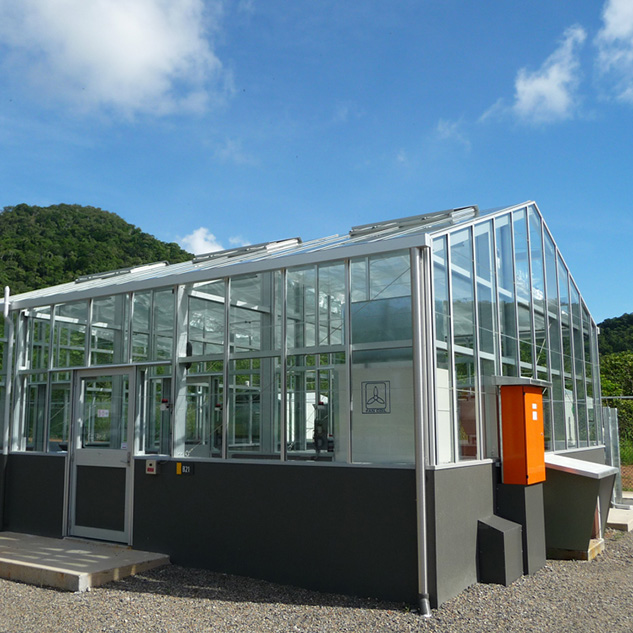

The TropOz facility is an active collaboration between JCU and the University of Exeter UK, and represents a unique experimental facility for investigating the impact of tropospheric ozone on tropical vegetation.
Urban expansion and land use change around the tropics is leading to higher concentrations of ozone (O3) an important atmospheric pollutant, with important impacts on primary productivity of natural and agronomic systems across the tropics. This facility consists of nine open top chambers (3.5 m diameter) with independent rates of O3fumigation, allowing for research into the impacts of both acute and chronic O3 pollution on tropical vegetation.
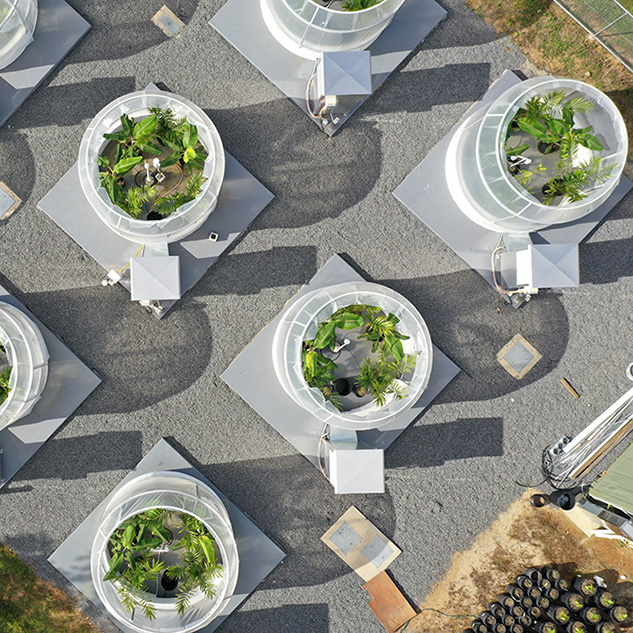
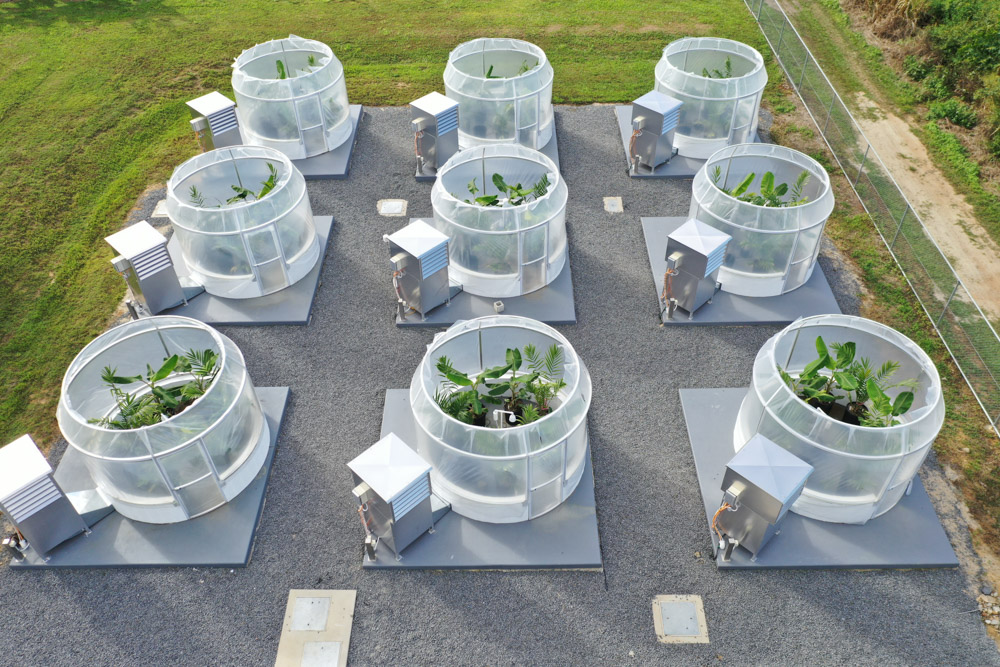
The shadehouse is a steel framed structure (10 x 5 m) with a 70% shade cloth covering and 2m wide double-gated doors at both ends. The shade house has a concrete floor with two centralised silt traps and is equipped with power and water.

The two flight cages are comprised of a steel frame enclosure with shade cloth cover. The structure is 4m tall with a 6m square base. The ante chamber is an additional 1500mm x 2200m footprint, and is double gated to prevent escape of animals. Entrance is comprised of a pair of 1m wide steel framed gates, repeated internally in the ante chamber. The two internal bays are separated by a double layer of mesh with a minimum of 50mm separation. Flight cages are equipped with power, water and centralised silt traps.
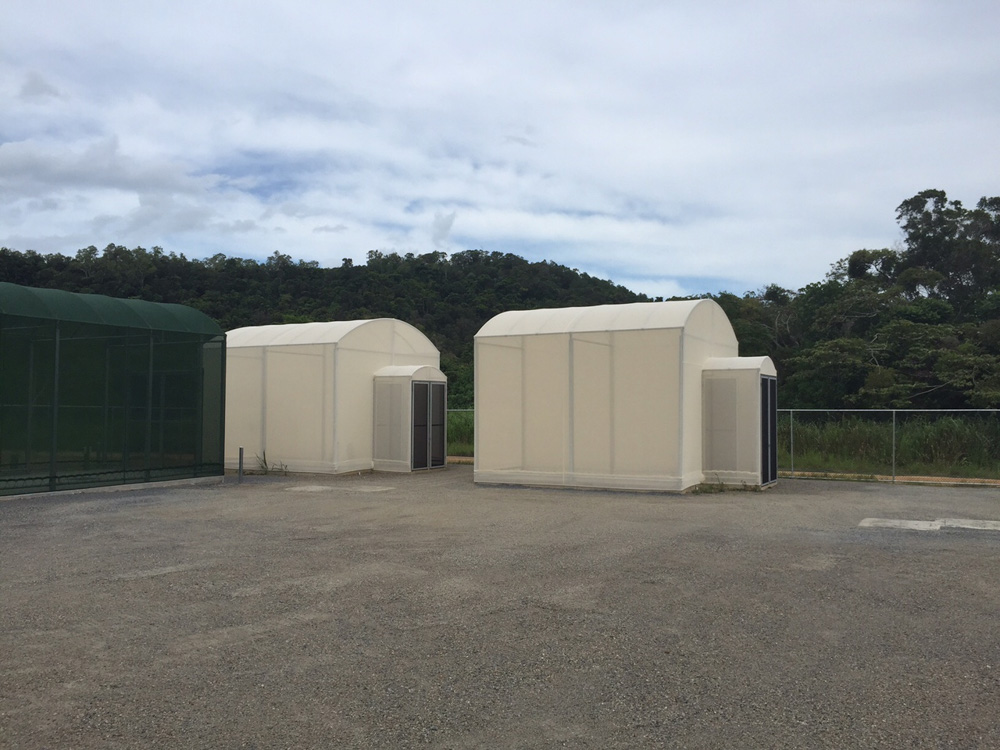
Six designated field research plots are available for short-term and long-term research projects.
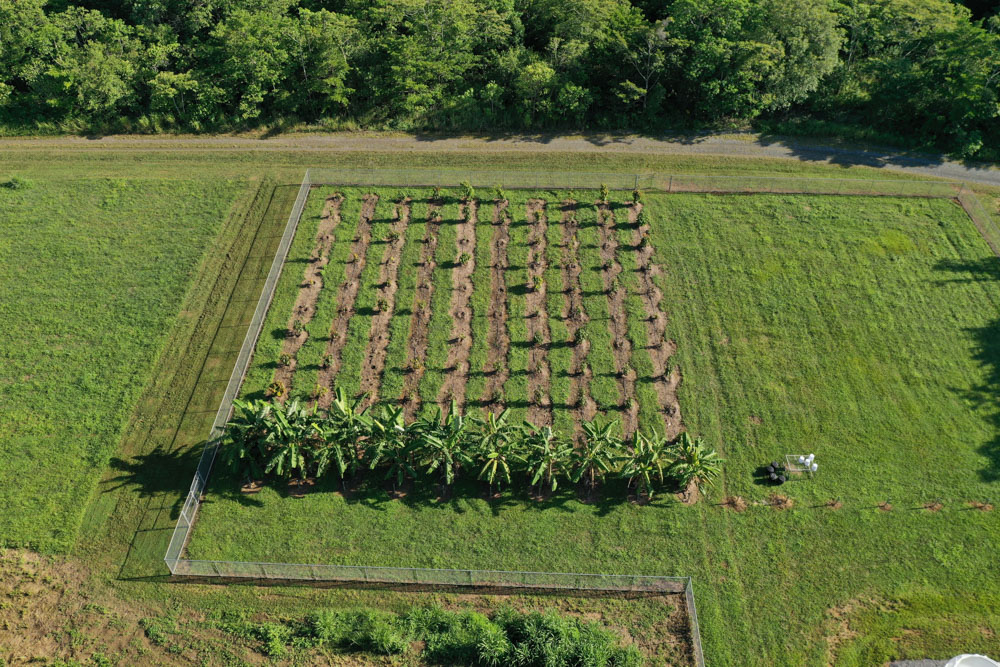
The Colorbond shed comprises power, water, internet, work area with benches and a sink. The shed is a multi-use area for conducting research along with storing of research supplies and equipment.
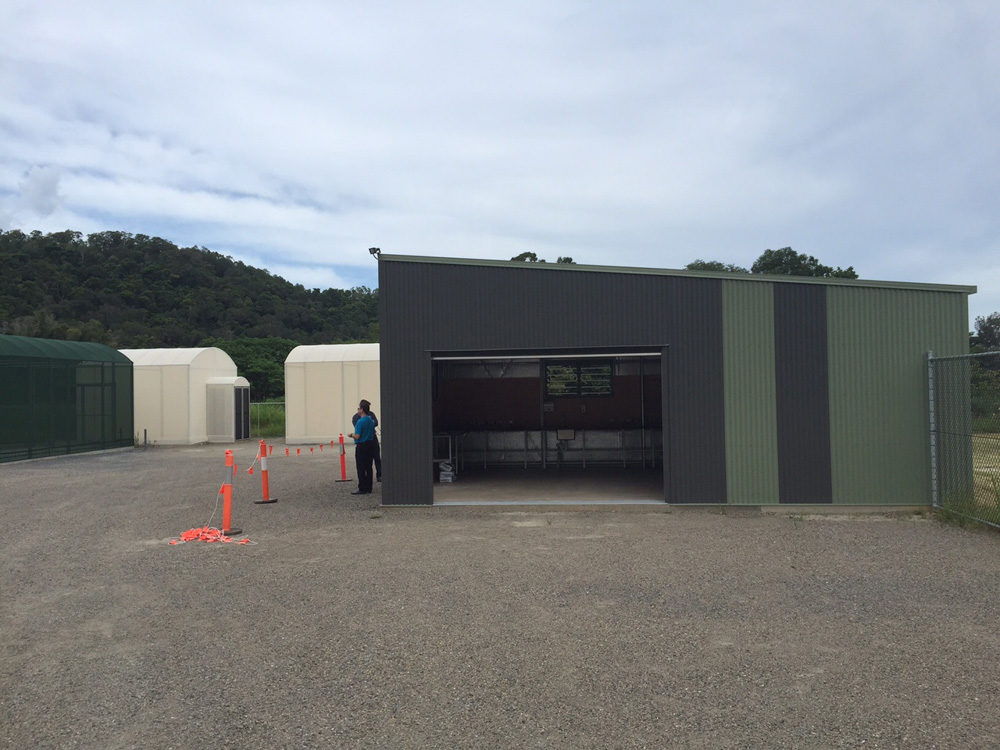
Three soil bays are built on top of a 250mm concrete slab. The walls are block construction of 1.8m in height. Each of the three bays is 3.8m deep and 3m wide.
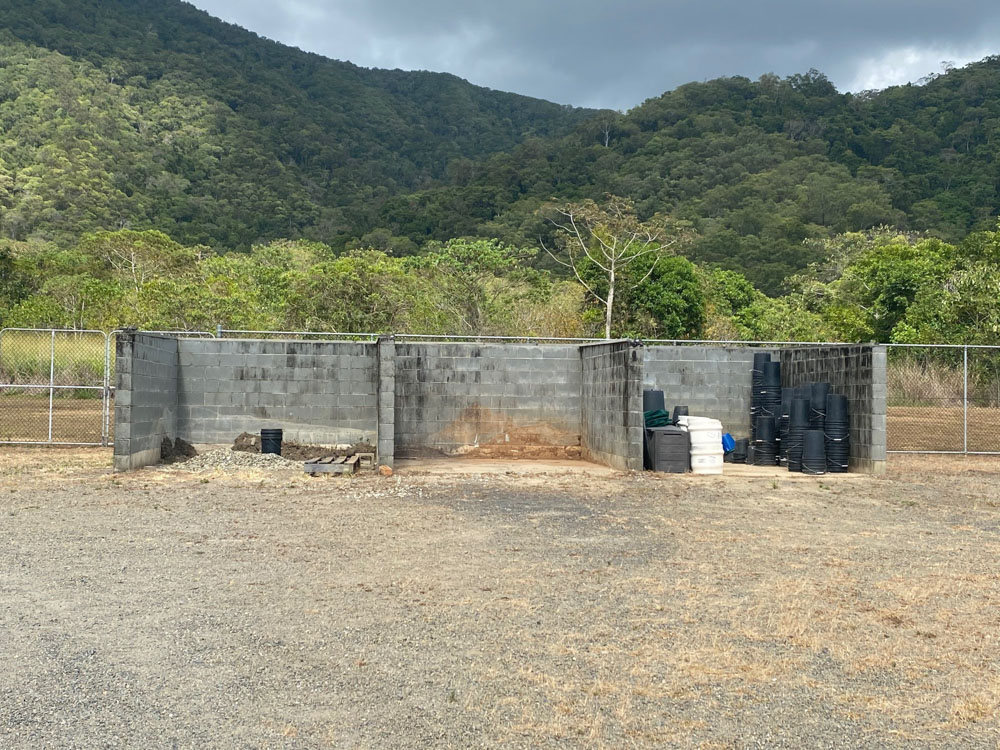
The Environdata Weather Master 3000 is an automatic weather station designed to suit a variety research, agricultural, commercial and industrial applications. Its powerful data logger is able to perform complex calculations along with remote communications.
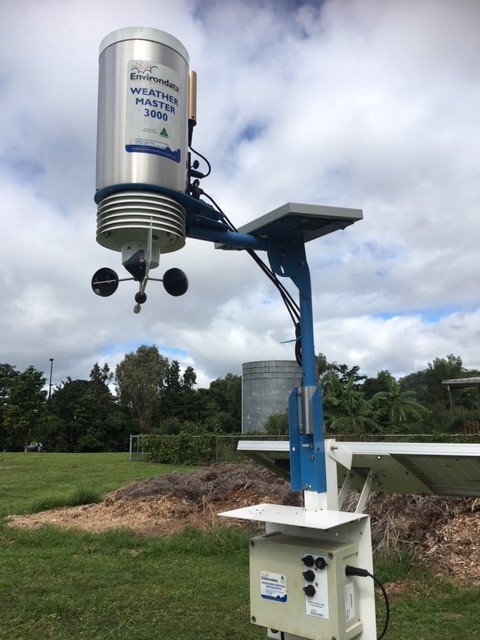
Weather stations built in sensors:
- Tipping Bucket Rain Gauge
- Wind Speed
- Wind Direction
- Air Temperature
- Relative Humidity
- Solar Radiation